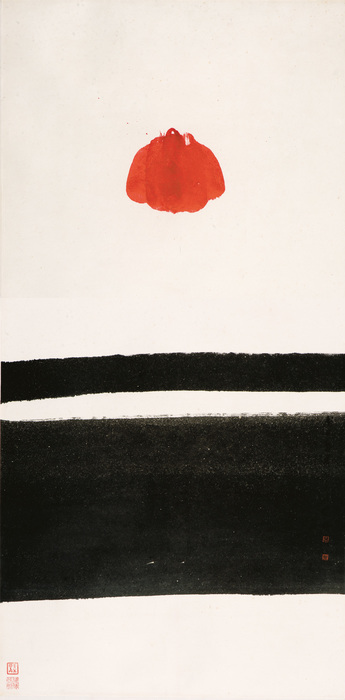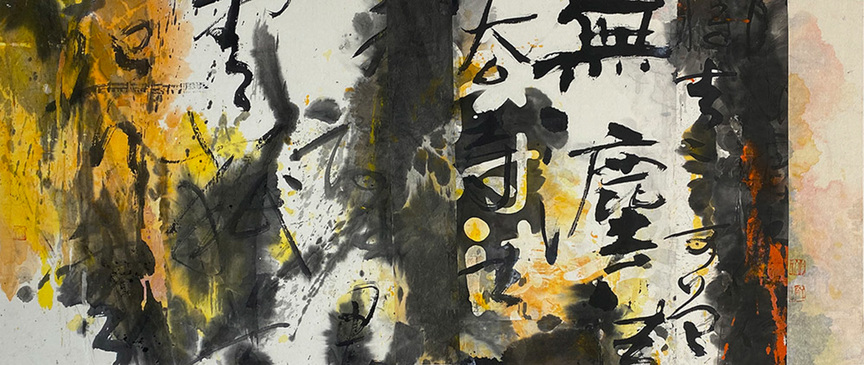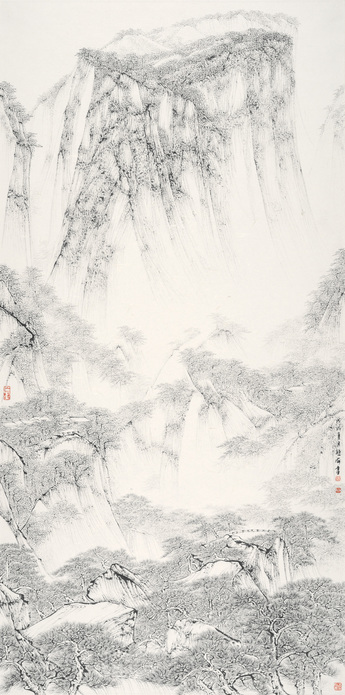-
From Current Issue
-
- Editor’s Letter Fire in the Heart
- Reviews I Gusti Ayu Kadek Murniasih
- Reviews 11th Seoul Mediacity Biennale: “One Escape at a Time”
- Dispatch Networked China
- One on One Monira Al Qadiri on Yukio Mishima
- Essays The rise of independent art spaces in pandemic-era Shanghai
- Features Tuan Andrew Nguyen
- Table of Contents
- Web Exclusives
- Archive
- Subscribe

R
E
V N
E
X
T
HUNG HOI, Below the Victoria Peak, Hong Kong, 2020, Chinese ink and color on rice paper, 29 × 42 cm. All images courtesy the artists and Alisan Fine Arts, Hong Kong.
All great cities are born from the energetic admixture of international trade and cultural influences. The exhibition of 28 artists at Alisan Fine Arts, “Uniquely Hong Kong – A Celebration of Hong Kong Art,” looked back on how today’s Special Administrative Region came to be one of those cosmopolitan destinations, producing a distinctive visual culture that revived Chinese traditions in the second half of the 20th century.
Many of the artists who arrived in the British colony to escape the brutal civil war of the 1940s and political purges of newly communist China in the ’50s had been trained in traditional ink painting and brought with them their conservative cultural sensibilities. Among this founding generation were the ink painters Lui Shou-kwan (1919–75), Irene Chou (1924–2011), and Fang Zhaoling (1914–2006), who were highlighted in a dedicated space in the exhibition. Lui, who arrived from Guangzhou in 1948 and went on to establish the New Ink Movement, revealed that modernist notions of abstraction could be boldly reinterpreted through ink in a balance of tradition and innovation in works such as Lotus (1968), a vertical rendering of a single red bulb above wide horizontal strokes of black ink. An émigré from Shanghai, Chou applied a deeply spiritual approach to Liu’s modernist credo, developing a singular style that far surpassed any of the avant-garde patriarchs of her generation (or subsequent ones) in originality, as was evident in the brooding composition around a series of loosely splattered brushstrokes, The Universe in My Heart, My Heart is the Universe II (2001). In contrast, Fang, arriving from Wuxi in 1950, hewed most closely to the conventions of landscape painting, working in the neoclassical tradition of her mentor, Zhang Daqian, as seen her in romanticized landscape Sailing Under the Red Sunset (1998).
The second clique of Hong Kong artists were those either born or raised in the colony such as Hon Chi Fun (1922–2019), who co-founded the all-male Circle Art Group, as well as Lui’s students Wucius Wong, Pat Hui, and Chui Tze-Hung. Abstraction dominates in the selections at Alisan from this generation, including Chui’s Collage to Juxtapose (2020) and Writing Wrongs and Rights (2020), which pair calligraphic and gestural marks; Hui and Wong’s Asking about Spring Messages by the Lake (2005), with the latter’s renderings of Tang and Song dynasty poems on the former’s colorfield ground; Hon’s Spell of Space (1994) featuring bold horizontal brushings; and Fung Ming Chip’s ultra-minimal trio Sailing Under the Stars / Waterfall / Sailing in the Moonlight (2017). All of these artists left Hong Kong in the decades before the 1997 Handover, though Wong, Chui, and Hon eventually returned.
The third chapter of “Uniquely Hong Kong” spanned the postmodern generations of the 1980s—including neoclassical shan shui painters and local chroniclers of daily urban life—to the artists of today. A deep, anti-modern nostalgia for millennia of Chinese culture is channeled through a trio of works from 2017–18 by Kan Tai-keung showing solitary (and presumably male) figures contemplating waterfalls, clouds, and trees in unblemished landscapes, while Hung Hoi explicitly draws on a classic Northern Song dynasty (c. 960–1127 CE) visual language in his rendering of unadulterated nature, Crystal-water Spring on Mount Hua (2018). Far more endearing in his humanism, the self-taught Chu Hing-Wah captures a fantastical scene of four birds following an elderly man through an urban landscape in The Penguin Walking Party (2016), inspired by a visit to the aquarium at Ocean Park. Chu’s paintings are paired with sculptures by Rosanna Li Wei-Han, famous for her (self-described) “fat lady” ceramics, one depicting an “auntie” with a shopping cart, Superwoman (2014), next to a pair sharing beers in Happy Hour Ladies’ Club (2007).
The millennial-generation artists featured in “Uniquely Hong Kong” are only those specifically working in revivals of traditional Chinese art-historical styles, and without overt reference to the political struggles of neocolonial Hong Kong. Cherie Cheuk Ka-wai paints in the ancient gongbi realist style, depicting birds amid swirling, menacing waves and rock formations, symbolically suggesting a world gone wrong. Riffing on a blue-and-white Ming dynasty ceramic pattern, Angel Hui Hoi Kiu renders famous artists—Vincent Van Gogh, Caravaggio, Frida Kahlo—wearing facemasks encircled by motifs referencing the Covid-19 pandemic, such as containers of bleach and disinfectant, bringing this exhibition survey right up to the present with what remains a uniquely Hong Kong perspective on the contemporary legacies of historical Chinese art.
HG Masters is the deputy editor and deputy publisher of ArtAsiaPacific.
“Uniquely Hong Kong – A Celebration of Hong Kong Art” is on view at Alisan Fine Arts’ Central gallery, Hong Kong, until September 26, 2020.
To read more of ArtAsiaPacific’s articles, visit our Digital Library.

















